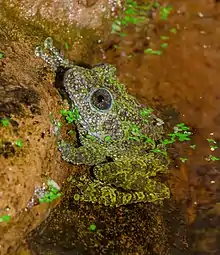Theloderma corticale
Theloderma corticale (common names: mossy frog,[2] Vietnamese mossy frog,[3] and Tonkin bug-eyed frog) is a species of frog in the family Rhacophoridae. It is found in northern Vietnam and China (Yaoshan, Guangxi (in the Dayaoshan National Nature Reserve), as well as from the Jianfengling National Nature Reserve in Hainan; the latter might represent misidentification),[4] and possibly in adjacent Laos.[5]

| Theloderma corticale | |
|---|---|
 | |
| Scientific classification | |
| Kingdom: | Animalia |
| Phylum: | Chordata |
| Class: | Amphibia |
| Order: | Anura |
| Family: | Rhacophoridae |
| Genus: | Theloderma |
| Species: | T. corticale |
| Binomial name | |
| Theloderma corticale (Boulenger, 1903) | |
| Synonyms | |
| |
Description
The common name "mossy frog" arises from the fact that its skin is a mottled green and brown that resembles moss growing on rock, and forms an effective form of camouflage. They have large sticky pads on their toes and a soft underbelly. They measure about 61 mm (2.4 in) in snout–vent length.[6] The females will grow larger than the males and can reach sizes of 8–9 cm (3.1–3.5 in). This species will curl into a ball when frightened, and play dead.[2][3]

Habitat and conservation
Its natural habitats are primarily evergreen rainforests and subtropical forest where they have been found inside pools in hollowed logs, placed by the local villagers. It is a semi-aquatic that is found in caves and steep rocky cliffs. Breeding takes place in rock cavities or tree holes.[1][2][3]
Its habitat is threatened by forest loss. It is also collected for international pet trade.[1] Like many amphibians, the Vietnamese mossy frog is vulnerable to the chytrid fungus Batrachochytrium dendrobatidis.
Diet
Theloderma corticale is insectivorous.[3]
References
- IUCN SSC Amphibian Specialist Group. 2017. Theloderma corticale. The IUCN Red List of Threatened Species 2017: e.T59033A87476136. https://dx.doi.org/10.2305/IUCN.UK.2017-2.RLTS.T59033A87476136.en. Downloaded on 30 September 2017.
- "Mossy Frog (Theloderma corticale)". World Association of Zoos and Aquariums. Retrieved 6 September 2015.
- "Vietnamese Mossy Frog (Theloderma corticale)". Newquay Zoo. Retrieved 6 September 2015.
- Frost, Darrel R. (2015). "Theloderma kwangsiense (Liu and Hu, 1962)". Amphibian Species of the World: an Online Reference. Version 6.0. American Museum of Natural History. Retrieved 6 September 2015.
- Frost, Darrel R. (2015). "Theloderma corticale (Boulenger, 1903)". Amphibian Species of the World: an Online Reference. Version 6.0. American Museum of Natural History. Retrieved 6 September 2015.
- Fei, L. (1999). Atlas of Amphibians of China (in Chinese). Zhengzhou: Henan Press of Science and Technology. p. 266. ISBN 7-5349-1835-9.
External links
 Media related to Theloderma corticale at Wikimedia Commons
Media related to Theloderma corticale at Wikimedia Commons Data related to Theloderma corticale at Wikispecies
Data related to Theloderma corticale at Wikispecies

